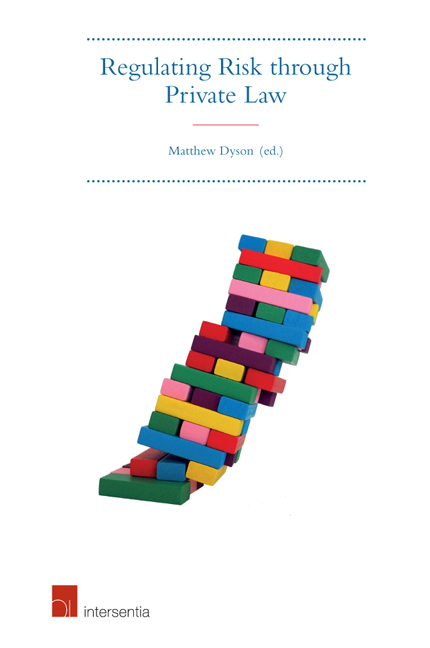Book contents
- Frontmatter
- Preface
- Contents
- Table of Cases
- List of Contributors
- Chapter 1 Introduction
- Part I Risk Overviews
- Part II State of the national art on risk
- Chapter 11 Legal Risk in International Commercial Disputes
- Chapter 12 Medical Accidents and Pharmaceutical Product Liability in France
- Chapter 13 Bearing and Sharing Risk in the Swedish Welfare State
- Chapter 14 Modernisation and Risk Regulation in the Italian Food Sector
- Chapter 15 Motor Vehicle Accidents Caused by Game Wandering onto Spanish Roads
- Chapter 16 Dutch Tort Law at the Crossroads: Judicial Regulation of Health and Environmental Risks
- Chapter 17 Sub Terra: Risk in the Chilean Mining Industry
- Chapter 18 Constitutionalising Rights and Reacting to Risk in South Africa
- Chapter 19 Regulating Risk in Brazil: Resort to General Clauses
- Chapter 20 What does Risk-Reasoning do in Tort Law?
- Chapter 21 Epilogue: What does Risk-Reasoning Tell Us about Tort Law?
- Index
- About the Editor
Chapter 14 - Modernisation and Risk Regulation in the Italian Food Sector
from Part II - State of the national art on risk
Published online by Cambridge University Press: 13 October 2018
- Frontmatter
- Preface
- Contents
- Table of Cases
- List of Contributors
- Chapter 1 Introduction
- Part I Risk Overviews
- Part II State of the national art on risk
- Chapter 11 Legal Risk in International Commercial Disputes
- Chapter 12 Medical Accidents and Pharmaceutical Product Liability in France
- Chapter 13 Bearing and Sharing Risk in the Swedish Welfare State
- Chapter 14 Modernisation and Risk Regulation in the Italian Food Sector
- Chapter 15 Motor Vehicle Accidents Caused by Game Wandering onto Spanish Roads
- Chapter 16 Dutch Tort Law at the Crossroads: Judicial Regulation of Health and Environmental Risks
- Chapter 17 Sub Terra: Risk in the Chilean Mining Industry
- Chapter 18 Constitutionalising Rights and Reacting to Risk in South Africa
- Chapter 19 Regulating Risk in Brazil: Resort to General Clauses
- Chapter 20 What does Risk-Reasoning do in Tort Law?
- Chapter 21 Epilogue: What does Risk-Reasoning Tell Us about Tort Law?
- Index
- About the Editor
Summary
INTRODUCTION
This second chapter from Italy takes up one particular theme to illustrate two important aspects of how private law regulates risks: the interactions within domestic law and the relationship between domestic law and international legal sources.
First, it is almost a truism to say that private law rules do not exist in a vacuum. Tort or contract law rules, for example, are considered as separate branches of the law for a number of purposes, but when the question is the allocation of responsibilities for the governance of certain risks, they surely come in as part of a larger picture. What is that picture? In particular, how do public law regimes interact with tort and contract law rules to regulate risk? As a preliminary point, although criminal law is present on the same scene as well, the role played by criminal law will not be explored in this context. Criminal law is mostly applied to individuals, while the accent here falls on the regulation of businesses.
The second point explored in this chapter highlights the interaction between EU law and the national legal systems with respect to risk regulation. To achieve the ends set by the European Treaties, all the Member States of the European Union have come to share a huge of amount of law. EU law has a pervasive and profound influence on the content and shape of the national legal systems of Europe, requiring more harmonisation and more uniformity across Europe. Private law is deeply involved in this movement, to the point that some commentators have decried the instrumentalisation of private law by the law of the European Union. Prime examples of this trend are the subordination of consumer information to market integration and the framing of the Product Liability Directive as a maximum harmonisation tool to advance the same goal, which is prioritised over the goal of pursuing justice among the parties. The legal cultures of the Member States and their identity are still quite different, however. The Treaty on the European Union pledges to respect pluralism, and to protect the national identities of the Member States (Arts. 1(2) and 4(2) TEU). How do these elements play out in reality? How do they play out in Italy in particular?
- Type
- Chapter
- Information
- Regulating Risk through Private Law , pp. 347 - 360Publisher: IntersentiaPrint publication year: 2018



